Gainward would like to prove to us that RTX is also cheap with the GeForce RTX 2060 Super Ghost. Today’s test will have to show us whether the concept of the very cost-effectively constructed card can work. The Nvidia-owned RTX alternatives without super in the appendix are slowly becoming rarer and those who buy new will probably have to arrange themselves super soon. It doesn’t have to be a disadvantage, but I don’t want to spoil anything yet. For this we have our new form of Plant-Profile, in order to be able to bring the facts, as desired (and also intended), shorter and more concise to the man, the woman or It, depending on the.
But back to the map, which I would like to take a closer look at today. What makes it interesting is the price that also makes it one of the cheapest GeForce RTX 2060, even if, of course, as always, everything depends on the miseral form of the day. But for that we love the street and its prices. You’re never sure of surprises.
The chip: TU106-410 of the GeForce RTX 2060 Super
The TU106-410 of the GeForce RTX 2060 Super is reduced to 2176 CUDA cores, 272 tensor cores, 34 RT cores, 136 TMUs and 64 ROPs compared to the full version TU106-400 on the RTX 2070. The card will have clock frequencies in the range of 1470 MHz (base clock) and 1650 MHz (boost) and can thus simultaneously deliver up to 7 TFLOPS computing power. The 34 RT cores can deliver about 6 giga-rays per second in ray tracing performance.
Compared to the RTX 2060, the RTX 2060 Super again has 4 MB L2 cache instead of the three MB of the RTX 2060. Otherwise, everything I have already written in the launch articles for the GeForce RTX 2070 FE and the GeForce RTX 2060 FE applies. And if you want to find out more about all the RTX features in detail, please refer to my long basic article “Nvidia GeForce RTX 2080 Ti and RTX 2080 – what is really hidden behind Turing” on the subject of RT. This, too, is read-proof and certainly worthwhile.
Uncircumcised, the TU106-410 also retains the same 256-bit memory bus as the TU106-400, which has eight 1 GB GDDR6 memory modules with 14 Gb/s data rate, resulting in bandwidth of up to 448 GB/s. As with the GeForce RTX 2070, NVLink support in this price range is long gone. A rogue who thinks evil in it, but what’s the point?
Although the TU106 is the least complex Turing-based GPU to date, its 445 mm2 chip contains no less than 10.8 billion transistors. That’s still huge for what Nvidia might once have considered the center of its portfolio. In comparison, the GP106, i.e. the “Midrange Pascal”, was a small 200 mm2 chip with 4.4 billion transistors.
Key data: unboxing, dimensions, weight and features
The palit card weighs only 582 grams and measures 23.6 cm from the outside edge of the slot panel to the outer edge of the radiator cover. With 11 cm from the top of the motherboard slot to the top edge of the cover, it is relatively flat and also the installation depth (“thickness”) of 3.8 cm makes it a real dual slot card. The radiator cover made of black ABS is rather inconspicuous, the backplate made of plastic is purely optical in nature. It cannot cool.
The slot bezel lets out a smaller part of the warm exhaust air directly, as the cooling fins are horizontally aligned. However, the rest disappears as usual in the depths of the housing. With a DVI port (digital only), a DisplayPort 1.4 and an HDMI 2.0 port, there are enough variants to connect to the monitor.
| Installation length (gross) | 23.6 cm |
| Installation height (gross) | 11.0 cm |
| Installation depth front (gross) | 3.8 cm |
| Installation depth rear (gross) | 0.5 cm (backplate) |
| Weight: | 582 g |
| Connections: | 1x HDMI 2.0 1x DisplayPort 1.4 1x DVI (digital) 1x 8-pin PCIe Power Supply |
| Cooler cover: | ABS injection moulding, solid black |
| Fan: | 2x 8.5 cm rotors with 9 rotor blades each |
A first overview of the electrical data here is the latest version of GPU-Z:
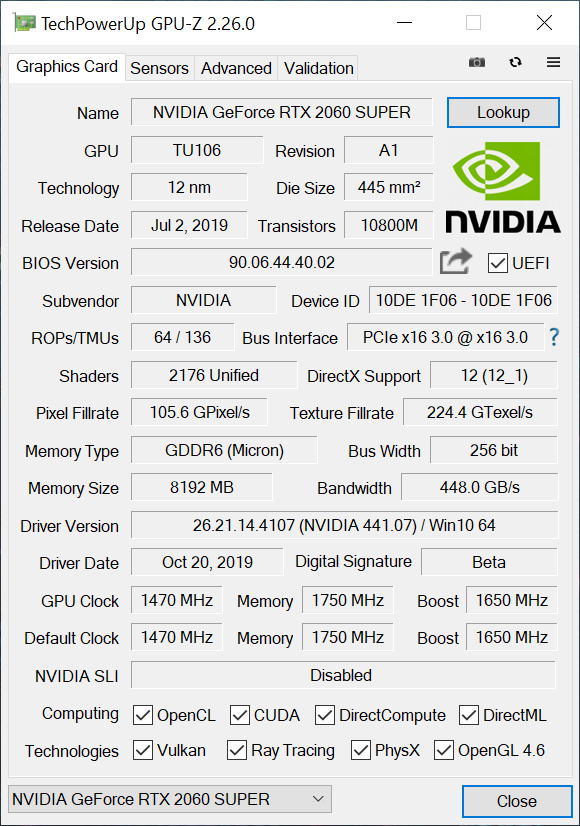
The overview of the relevant comparison maps then looks like this:
| GeForce RTX 2060 Super |
GeForce RTX 2060 FE | GeForce RTX 2070 FE |
GeForce GTX 1070 FE |
|
| Architecture (GPU) |
Turing (TU106-410) | Turing (TU106-300) | Turing (TU106-400) | Pascal (GP104) |
| CUDA Cores |
2176 | 1920 | 2304 | 1920 |
| Tensor Cores |
272 | 240 | 288 | N/A |
| RT Cores |
34 | 30 | 36 | N/A |
| Texture Units |
136 | 120 | 144 | 120 |
| Base Clock Rate |
1470 MHz | 1365 MHz | 1410 MHz | 1506 MHz |
| GPU Boost Rate |
1650 MHz | 1680 MHz | 1710 MHz | 1683 MHz |
| Storage expansion |
8GB GDDR5 | 6GB GDDR6 | 8GB GDDR6 | 8GB GDDR5 |
| Storage bus |
256-bit | 192-bit | 256-bit | 256-bit |
| Bandwidth |
448 GB/s | 336 GB/s | 448 GB/s | 256 GB/s |
| Rops |
64 | 48 | 64 | 64 |
| L2 Cache |
4 MB | 3 MB | 4MB | 2MB |
| Tdp |
175 W | 160 W | 185W | 150w |
| Transistors |
10.8 billion | 10.8 billion | 10.8 billion | 7.2 billion |
| The size |
445 mm2 | 445 mm2 | 445 mm2 | 314 mm2 |
| Sli |
No | No | No | Yes (MIO) |
Test system and setup
Elegant transition and also a view of the test system, which this time relies on AMD’s socket AM4 and X570, Intel’s socket 2066 on the X299 and the socket 1151 including Z390. I used only tried-and-tested boards from MSI (X570, Z390), as well as Aorus (X299). The final question of what to do with RAM has long been a matter of concern to me. Should I run the 32 GB DDR4 on the same clock as the processor manufacturer specifies in the specs, or should I run all CPUs with the same clock?
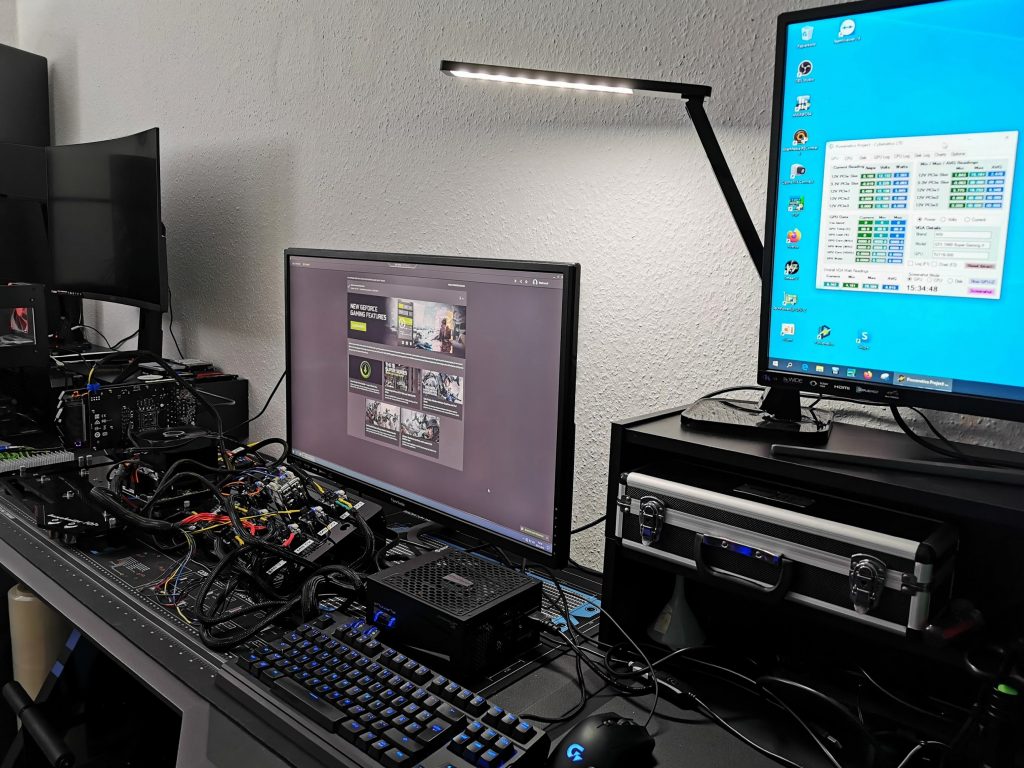
The 32 GB extension is new and fits the velvet system. I have listed this tabularly again in detail:
| Test System and Equipment |
|
|---|---|
| Hardware: |
Intel Core i9-9900 K 4x 8GB G.Skill FlareX DDR4 3200 |
| Cooling: |
Alphacool Ice Block XPX (1151), XPX Pro (AM4, 2066) Alphacool Ice Grinder (modified) Thermal Grizzly Kryonaut |
| Case: |
Lian Li T70, Raijintek Paean Open Benchtable |
| Monitor: | BenQ PD3220U |
| Power Consumption: |
Non-contact direct current measurement on PCIe slot (riser card) |
| Thermal Imager: |
1x Optris PI640 + 2x Xi400 Thermal Imagers Pix Connect Software Type K Class 1 thermal sensors (up to 4 channels) |
| Acoustics: |
NTI Audio M2211 (with calibration file) Steinberg UR12 (with phantom power for the microphones) Creative X7, Smaart v.7 Own anechoic chamber, 3.5 x 1.8 x 2.2 m (LxTxH) Axial measurements, perpendicular to the center of the sound source(s), measuring distance 50 cm Noise emission in dBA (slow) as RTA measurement Frequency spectrum as graphic |
| Os: | Windows 10 Pro (1909, all Updates) |
Gainward GeForce RTX 2060 SUPER Ghost, 8GB GDDR6, DVI, HDMI, DP (1198)














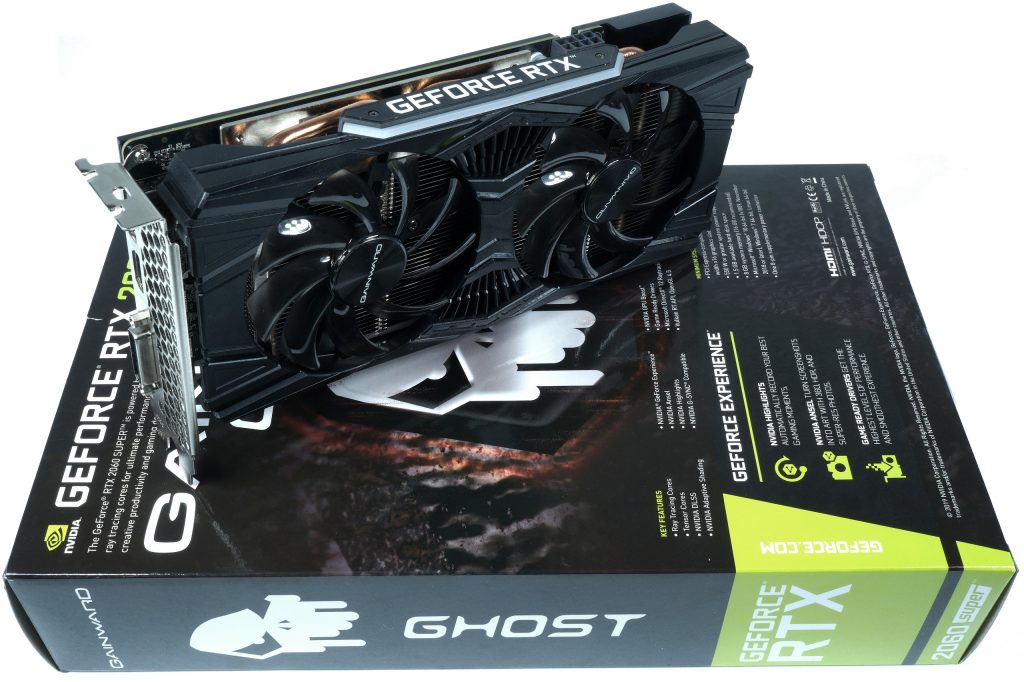
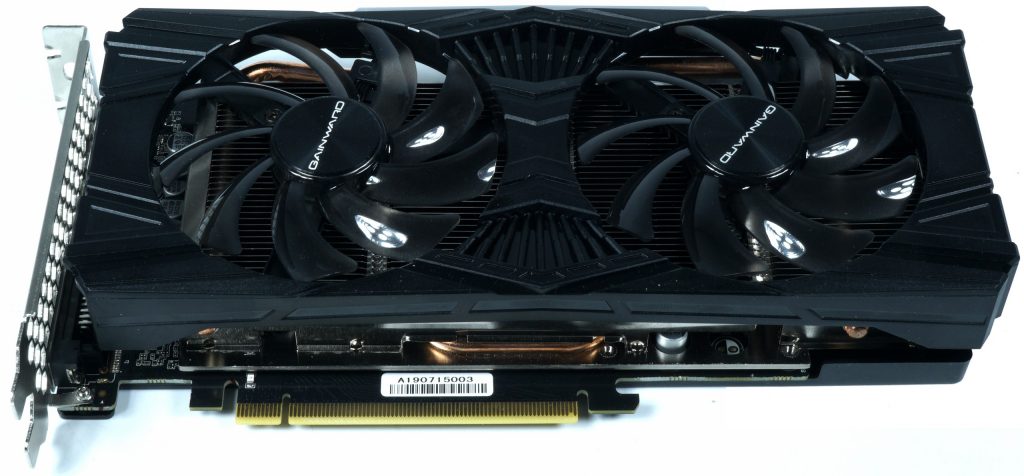
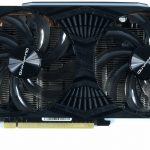
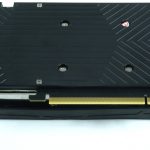
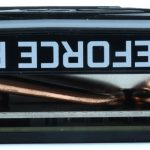
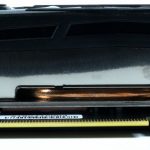



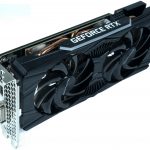





Kommentieren